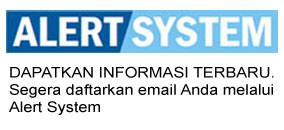Silakan login untuk mengakses laman berikut
Archive for 2013
Kelas Kursus Pelatihan Sistem Akuntansi Rumah Sakit berbasis SAK
Silakan login untuk mengakses laman berikut
Hospitals taking medical care to the homeless to cut ER visits
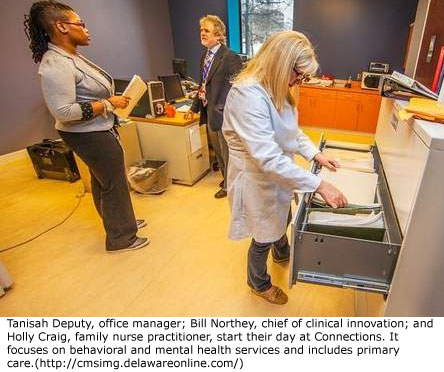 Seeking appropriate medical care often tumbles to the bottom of the priority list for many people who struggle with keeping a permanent place to live.
Seeking appropriate medical care often tumbles to the bottom of the priority list for many people who struggle with keeping a permanent place to live.
So they put off needed care, ignoring uncontrolled diabetes, kidney problems or a worsening skin infection until the situation becomes acute. And when the problem can’t be eased, they wind up in the emergency department or being admitted to the hospital.
It can become an expensive – and medically unsatisfying – cycle.
During a survey of Delaware’s homeless last summer, volunteer teams counted 108 people living on the streets who had either been hospitalized or treated at the emergency department in the last year, at an estimated annual cost of almost $5.5 million, about $51,000 per person.
“I think the major challenge is not that people experiencing homelessness don’t access medical care, because they do. It’s that they access expensive medical care like emergency rooms because they don’t have a medical home, said Susan Starrett, executive director of the Homeless Planning Council of Delaware, which helped coordinate the survey.
Several programs across Delaware are trying to help those who struggle with homelessness, lack of social support, chronic illness or other issues take charge of their medical care so they don’t wind up in the hospital or emergency department by default.
The intention is to empower patients to take control of their health using the mobile approach taken by the St. Clare Medical Outreach Van, which provides free primary care services for the uninsured and underinsured, or Christiana Care Health System’s Medical Home Without Walls, which has staff visiting patients where they are – whether it’s a home, shelter or on the streets – and when needed, accompanying them to their medical visits.
That doesn’t mean forcing unwanted decisions upon this vulnerable population, said Dr. Diane Bohner, medical director of the Christiana Care program.
“We don’t set the agenda for patients,” said Bohner, also medical director of Patient and Family Centered Care and resource management at Christiana Care. “They just want to figure out what the patient wants for themselves. One of the things I recognized is that everyone’s need is different. We assess to determine what’s the best intervention strategy.”
Source: delawareonline.com
Pihak Rumah Sakit Harus Paham UU Tentang Rumah Sakit
 Jakarta – Anggota Komisi IX DPR Poempida Hidayatulloh mengaku, malam tadi menerima sepucuk surat dari keluarga Annisa Azwar. Annisa yang merupakan mahasiswa Ilmu Keperawatan Universitas Indonesia (UI) Annisa Azward diketahui meninggal dunia akibat terjatuh dari angkutan kota kota U-10 rute Sunter-Kali Pasir, karena diduga menghindari ancaman kejahatan.
Jakarta – Anggota Komisi IX DPR Poempida Hidayatulloh mengaku, malam tadi menerima sepucuk surat dari keluarga Annisa Azwar. Annisa yang merupakan mahasiswa Ilmu Keperawatan Universitas Indonesia (UI) Annisa Azward diketahui meninggal dunia akibat terjatuh dari angkutan kota kota U-10 rute Sunter-Kali Pasir, karena diduga menghindari ancaman kejahatan.
Kemudian, Annisa langsung dibawa ke Rumah Sakit Atmajaya, Pluit, Jakarta Utara. Di sana, Annisa diberi tindakan CT Scan dan dinyatakan harus segera dioperasi dan dirawat di ICU. Parahnya, sudah tau ada korban yang memang butuh perawatan cepat, pihak rumah sakit malah meminta keluarga untuk menyetor uang Rp12 juta terlebih dahulu.
Keluarga yang tidak menyanggupi jumlah uang tersebut kemudian memindahkan Annisa ke Rumah Sakit Koja keesokan harinya. Saat di Rumah Sakit Koja, pihak keluarga juga mengaku ada yang aneh karena Annisa dibiarkan menunggu dua jam di UGD. Setelah dari UGD, Annisa tidak diharuskan operasi dan dimasukkan ke ruang rawat inap biasa, bukan ICU.
Atas adanya kejadian itu, Poempida yang duduk di Komisi Kesehatan DPR itu menghimbau semua Rumah Sakit dapat mendalami Undang-Undang tentang Rumah Sakit, yang jelas-jelas mewajibkan Rumah Sakit untuk menangani pasien, terutama yang dalam keadaan gawat darurat.
“Saya desak Kementerian Kesehatan RI untuk memberikan sanksi bagi setiap RS yang tidak mengindahkan UU tentang Rumah Sakit tersebut,” kata Poempida dalam pesan singkat yang diterima wartawan, Selasa (19/3/2013).
Penolakan pihak Rumah Sakit terhadap pasien tidak mampu memang kerap terjadi belakangan ini, dari kasus meninggalnya mahasiswi Universitas Indonesia (UI) Anisa Azwar akibat tidak mendapat pertolongan maksimal dari sebuah rumah sakit, dan seorang anak bernama Dera yang mengalami gangguan pernapasan yang mengalami perlakuan serupa.
Sumber: utama.seruu.com
Pemprov DKI Evaluasi Kinerja Rumah Sakit
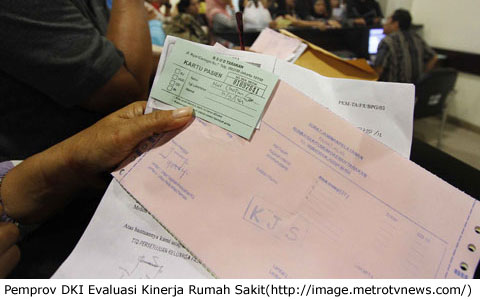 Jakarta: Pemprov DKI akan mengevaluasi kinerja pelayanan rumah sakit terhadap warga Jakarta, khususnya peserta Kartu Jakarta Sehat (KJS).
Jakarta: Pemprov DKI akan mengevaluasi kinerja pelayanan rumah sakit terhadap warga Jakarta, khususnya peserta Kartu Jakarta Sehat (KJS).
Evaluasi dilakukan atas kinerja sejak diluncurkannya Kartu Jakarta Sehat (KJS) pada November 2012, kata Wakil Gubernur (Wagub) DKI, Basuki Tjahaja Purnama (Ahok), di Balai Kota DKI, Senin 918/3).
Ahok mengatakan, Gubernur DKI, Joko Widodo, akan mengumpulkan beberapa rumah sakit yang sudah menandatangani kontrak kerja sama melalui program KJS. Pertemuan itu tidak hanya mengevaluasi pelaksanaan KJS, juga mengevaluasi kinerja rumah sakit (RS) dalam melayani pasien KJS.
“Iya, Pak Gubernur mau ketemu beberapa rumah sakit untuk ngomong. Mau dievaluasi,” kata Ahok.
Dalam pertemuan tersebut, lanjutnya, juga akan mengetahui apakah ada pasien yang dimintai bayaran sama pihak RS atau diberikan obat non generik dan biaya ditanggung pasien. Karena peserta KJS diupayakan diberikan obat generik secara gratis.
“Sampai saat ini sich belum ada laporan seperti itu. Kan kita belum jalan sepenuhnya. Kalau tidak kita uji coba pada November tahun lalu maka kita tidak bisa melakukan evaluasi kan. Tadinya kami pikir evaluasi KJS bisa dilakukan sekitar Februari, ternyata ada keterlambatan pengesahan APBD. Makanya baru dilakukan sekarang,” ujarnya.
Namun bila ada laporan atau ditemukan bukti ada RS swasta maupun rumah sakit umum daerah (RSUD) yang meminta bayaran baik untuk biaya perawatan maupun obat-obatan, Pemprov DKI akan langsung memberikan sanksi seberat beratnya. Yakni dengan langsung membekukan izin operasionalnya dan melaporkan tindakan tersebut ke Ikatan Dokter Indonesia (IDI) atau Ikatan Rumah Sakit Jakarta Metropolitan (IRSJM).
“Kalau ada rumah sakit yang masih tarik biaya, kita akan kenakan sanksi. Bisa saja izin operasionalnya kita bekukan, kita laporkan ke IDI dan laporkan ke organisasi asosiasi rumah sakit swasta. Tapi kita mau tahu dululah, nanti ketahuan rumah sakit mana yang nakal dan yang tidak,” ujarnya.
Menurut dia, biaya obat paten atau non generik tidak boleh dibebankan kepada pasien. Untuk mengantisipasi masalah tersebut, pemprov akan melibatkan Komite Medis yang tengah digarap Dinas Kesehatan DKI.
Komite Medis akan memutuskan perlu atau tidaknya mengambil tindakan tertentu, termasuk menentukan pemberian obat nongenerik atau generik kepada pasien KJS.
“Tidak boleh dimintakan biaya obat, meskipun itu obat non generik. Makanya kita butuh komite medis untuk memutuskan perlu atau tidak mengambil tindakan tertentu. Kalau memang perlu kita tanggung. Namanya orang tidak mampu, kalau tidak kita tanggung, ya mati dong,” ucapnya
Sumber: metrotvnews.com
Meresahkan, Ledakan Jumlah Pasien Rumah Sakit Akibat Biaya Gratis
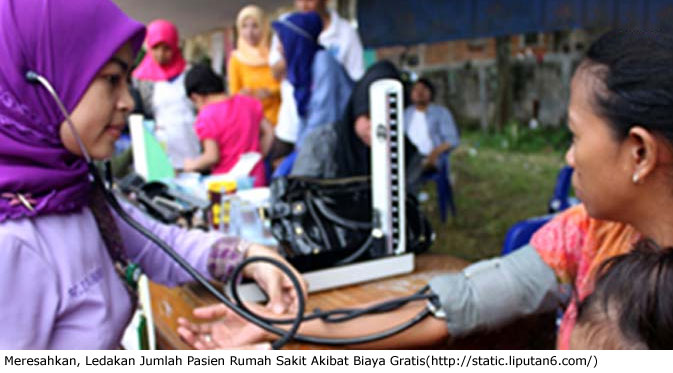 Jakarta : Ledakan pasien di beberapa rumah sakit di DKI Jakarta menyusul diluncurkannya fasilitas kesehatan gratis, membuat Perhimpunan Rumah Sakit Seluruh Indonesia (PERSI), Asosiasi Klinik Indonesia (ASKLIN) dan Yayasan Pemberdayaan Konsumen Kesehatan Indonesia (YPKKI) menyatakan deklarasi bersama.
Jakarta : Ledakan pasien di beberapa rumah sakit di DKI Jakarta menyusul diluncurkannya fasilitas kesehatan gratis, membuat Perhimpunan Rumah Sakit Seluruh Indonesia (PERSI), Asosiasi Klinik Indonesia (ASKLIN) dan Yayasan Pemberdayaan Konsumen Kesehatan Indonesia (YPKKI) menyatakan deklarasi bersama.
Menurut Ketua Umum PERSI Dr. dr. Sutoto, M. Kes, deklarasi ini dibuat setelah melihat kenyataan melonjaknya pasien-pasien di berbagai rumah sakit karena semua pasien ingin dilayani, juga tarif yang disesuaikan pemerintah dirasa menjadi penyebab meruginya beberapa rumah sakit.
Bukan hanya itu, menurut Sutoto di beberapa daerah seringkali pelayanan kesehatan dimanfaatkan oleh calon gubernur (cagub) dan calon bupati untuk jualan menjelang pemilihan kepalada daerah.
“Saya kira pelayanan rumah sakit tidak bisa dimasukkan ke dalam area politik. Ada beberapa daerah bahkan dalam pembayaran untuk sistem askes dan alat sangat lambat sehingga mempengaruhi cash flow rumah sakit,”jelas Sutoto.
Sutoto menjelaskan kalau di beberapa daerah terjadi penumpukan utang. Ini menyebabkan rumah sakit kesulitan mendapatkan alat, obat bahkan sekadar membayar pegawai atau jasa profesional.
Untuk itu, diberlakukannya Sistem Jaminan Sosial Nasional (SJSN), Persi, Asklin dan YPKKI menyatakan deklarasi bersama yang berisi:
1. Kami mendukung pelaksanaan UU SJSN dan UU BPJS yang dilaksanakan per 1 Januari 2014
2. Mendesak pemerintah menetapkan besaran iuran PBI (Penerima Bantuan Iuran) berdasarkan perhitungan biaya keekonomian yang mendukung akses dan mutu pelayanan kesehatan oleh fasilitas pelayanan kesehatan yang mengutamakan keselamatan pasien
3. Mendesak presiden mengalokasikan dalam APBN 2014 untuk menjamin 86,4 juta jiwa peserta PBI per jiwa adalah sebesar Rp 22.500 sampai Rp 27.000
4. Pemerintah dan DPR segera merealisasikan UU (Undang-undang) kesehatan yang mengamanatkan anggaran untuk kesehatan minimal sebesar 5 persen dari APBN.
5. Pemerintah segera meralisasikan Teknologi Informasi untuk mendukung penerapan sistem rujukan pelayanan kesehatan Nasional terpadu.
6. Tarif INA CBG’s untuk pembiayaan Jaminan Kesehatan Nasional harus mengikuti harga keekonomian sejak awal pemberlakuannya, serta harus ada penyesuaian tarif INA CBG’s untuk rumah sakit non pemerintah khususnya yang tidak mendapatkan subsidi.
Sumber: health.liputan6.com
How Good Is Your Hospital? Depends Who You Ask
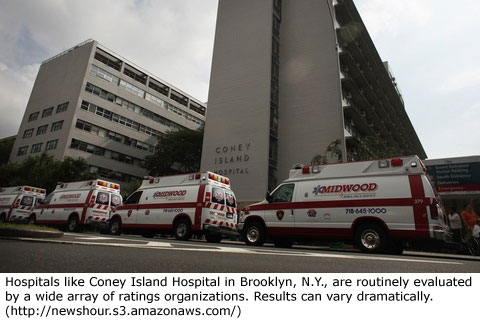 How good a hospital is St. Mary Mercy Livonia Hospital? Depends on whom you ask.
How good a hospital is St. Mary Mercy Livonia Hospital? Depends on whom you ask.
The Leapfrog Group, a respected nonprofit that promotes patient safety, gave an “A” to this Michigan hospital. The company Healthgrades named it one of America’s best 50 hospitals.
But the Joint Commission, a nonprofit organization that accredits hospitals, and U.S. News and World Report omitted St. Mary from their best hospital lists. Consumer Reports gave it an average safety score of 47 points out of 100, citing high numbers of readmissions, poor communication with patients and excessive use of scans. Medicare, which has a new program rewarding hospitals for meeting certain quality measures, is reducing St. Mary’s payments by a fraction this year.
Evaluations of hospitals are proliferating, giving patients unprecedented insight into institutions where variations in quality can determine whether they live or die. Many have similar names, such as “Best Hospitals Honor Roll,” “America’s Best Hospitals” and “100 Top Hospitals.” Illinois,Florida and other states have created their own report cards. In some places, such as California, there are more than a dozen organizations offering assessments on hospital quality.
But those ratings, each using its own methodology, often come to wildly divergent conclusions, sometimes providing as much confusion as clarity for consumers. Some hospitals rated as outstanding by one group are ignored or panned by another. Ratings results from an individual group can change significantly from year to year.
“We’ve alternatively been labeled the least safe hospital in Maine and the safest hospital in Maine,” said Dr. Douglas Salvador, vice president of quality at Maine Medical Center in Portland.
And the ratings do not always jibe with the views of authorities who oversee hospitals. For instance, UCSF Medical Center has gotten good grades from multiple safety raters even as California public health officials have fined it $425,000 repeatedly for endangering patients. As ratings multiply, more and more hospitals have something they can boast about. A third of U.S. hospitals — more than 1,600 — last year won at least one distinction from a major rating group or company, according to a Kaiser Health News analysis. In the greater Fort Lauderdale hospital market, 21 of 24 hospitals were singled out as exemplary by at least one rating source. In the Baltimore region, 19 out of 22 hospitals won an award.
“I worry a lot about these ratings,” said Jerod Loeb, executive vice president for health care quality evaluation at the Joint Commission. “They’re all justifiable efforts to provide information, but at the end of the day every single one of them is flawed in some respect. Rather than enlightening, we may be confusing.”
Not A ‘Complete Picture Of The Care’
There are so many report cards on hospitals that the Informed Patient Institute runs a website that grades the raters. Carol Cronin, its executive director, said most report cards are not easy for consumers to use. “A lot of them don’t help users quickly understand which hospital is better than another,” she said.
But many hospitals are eager to trump these distinctions in their marketing. Healthgrades, U.S. News and Leapfrog not only encourage this but also profit from it by charging licensing fees to hospitals that want to advertise their awards. “A hospital cannot buy an award, they must achieve it,” Healthgrades said in a statement.
Healthgrades and Truven Health Analytics, which publishes the 100 Top Hospitals, offer consulting services to hospitals that want to improve their overall performances. Jean Chenoweth, a Truven senior vice president, said the list doesn’t earn Truven any money but it “gives the company a lot of visibility.”
Dr. Andrew Brotman chief clinical officer at NYU Langone Medical Center in Manhattan, said the fees can be substantial. “Healthgrades, which is one we did well on, charges $145,000 to use this even on the website as a logo, so we don’t do that,” he said. “U.S. News is in the $50,000 range. Leapfrog is $12,500.”
Consumer Reports bars hospitals from using its ratings in marketing, but patients must subscribe to read them online. (Others generally provide free access to ratings on their sites.) The Joint Commission does not charge hospitals that make its top quality list.
A Pew Research Center survey found 14 percent of Internet users consulted online rankings or reviews of hospitals and medical facilities. Florence Harvey, 70, said when she moved to Washington, D.C., last fall, she picked a health plan and doctor affiliated with Washington Hospital Center after reviewing all the local hospitals rankings on U.S. News’ website. “That was the one that had the best across-the-board ratings,” she said.
But Harvey may be an anomaly. Dr. Peter Lindenauer, a professor with Tufts University School of Medicine based in Springfield, Mass., said the limited research on rankings “suggests they have had very little impact on patient behavior.”
‘Patient Safety Has To Be A Priority’
That’s not surprising since many admissions, such as those due to a heart attack or car crash, have an immediacy that rules out comparison shopping. Also, researchers note, many patients defer to their physicians’ recommendations or go to the hospital where their chosen surgeon has privileges. Still, rating groups say the ratings help keep the pressure on hospital executives to keep quality up.
“Patient safety has to be a priority 24-7,” said Leah Binder, Leapfrog’s president. “The minute it slips off the priority list, that impacts the rating.”
The calculations that go into these ratings are complex. Most hospital assessments synthesize dozens of pieces of data Medicare publishes on its Hospital Compare website, including death rates and the results of patient satisfaction surveys. They also examine other sources and use private surveys to create user-friendly lists or grades, which they display on their websites.
The Joint Commission looks at how frequently patients received recommended treatments, such as flu shots for those with pneumonia. Consumer Reports examines the numbers of patients who die or are readmitted, infection rates and Medicare patient surveys of their experiences. Leapfrog looks at data from its surveys of hospitals, the consistency with which hospitals followed safe surgical practices and frequencies of infections and some types of patient harm. Healthgrades analyzes detailed Medicare records to find death and complication rates for 27 procedures and conditions.
“Ratings and ranking programs certainly offer people information they can use to make their hospital selections, but we don’t recommend relying on any one of them completely,” Jennifer Kennedy, a spokeswoman for St. Mary Mercy, said in an e-mail. “None are able to tell the whole story or paint a complete picture of the care that is delivered.”
The ratings groups believe the public benefits from the multitude of ratings. Dr. John Santa, who directs Consumer Reports’ health ratings, said consumers benefit from different vantages just as they do for cars or electronic devices, and the competition spurs each rating group to get better. “We think that’s consistent with good science,” Santa said.
Avery Comarow, health rankings editor for U.S. News, agrees. “People go to hospitals for different reasons and priorities,” he said. “I’m not sure there could be a single rating system that can do it all.”
Some of the hospitals that do the best in the rankings have limited respect for them. Advocate Christ Medical Center in Oak Lawn, Ill., last year received praise from Leapfrog, U.S. News, the Joint Commission, Truven and Healthgrades. But Dr. William Adair, vice president for clinical transformation, says the hospital doesn’t license any of the distinctions. “We’re all made a little bit uneasy, to be frank about it,” Adair says. “Some of these organizations are looking for revenue. It blurs the effectiveness of the ratings processes.”
Still, many hospitals are happy to use the praise. Dr. Brotman from NYU said: “Even though there’s not a hospital executive who won’t tell you that they have a great deal of skepticism about a lot of the methodology, there’s not one who will tell you they don’t want to be on the lists.”
Source: pbs.org
Rumah Sakit Dukung Evaluasi Kartu Sehat Jokowi
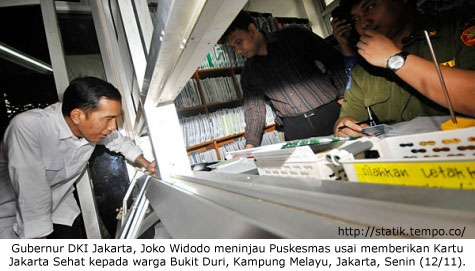 Jakarta – Sejumlah rumah sakit di Jakarta menyepakati evaluasi yang diberikan Gubernur DKI Jakarta Joko Widodo mengenaiprogram Kartu Jakarta Sehat (KJS) yang diluncurkan pada 10 November lalu.
Jakarta – Sejumlah rumah sakit di Jakarta menyepakati evaluasi yang diberikan Gubernur DKI Jakarta Joko Widodo mengenaiprogram Kartu Jakarta Sehat (KJS) yang diluncurkan pada 10 November lalu.
Rumah Sakit Umum Pusat Fatmawati, misalnya, setuju bila sistem rujukan KJS segera diperbaiki. “Sangat bagus yang ditawarkan Pak Gubernur. Itu yang diinginkan semua rumah sakit,” kata Direktur Umum, SDM, dan Pendidikan RS Fatmawati, drg. Setyawati, di Balai Kota Jakarta, Senin, 18 Maret 2013.
Menurut Setyawati, sistem rujukan saat ini dirasakan yang paling merepotkan. Dia meminta hal tersebut segera diperbaiki. Begitu pula dengan urusan penagihan klaim pembayaran seiring peningkatan jumlah pasien rumah sakit sejak adanya KJS. “Sampai 20 persen,” ujarnya.
Di lain pihak, Direktur Rumah Sakit Cinta Kasih dr. Subekti mengatakan pihaknya akan memperbanyak ruangan di rumah sakit. Ini merespon janji Jokowi yang akan memberi insentif bagi rumah sakit yang menyediakan 70 persen kamar kelas III. Sebenarnya, sejak didirikan, 100 persen ruangan RS Cinta Kasih sudah untuk kelas III dengan 40 tempat tidur. “Semoga bisa terlaksana dengan kemudahan yang diberikan,” ujar Subekti.
Kebijakan Jokowi juga didukung birokrasinya. Kepala Suku Dinas Kesehatan Jakarta Selatan Kurnianto Amin mengatakan arahan Gubernur sangat bermanfaat. Dengan sistem rujukan yang benar, maka pasien di rumah sakit dapat berkurang.
“Harus ada rujukan. Tanpa rujukan, masyarakat harus membayar seperti pasien umum, tidak ditanggung dengan KJS,” katanya.
Sumber: tempo.co
Manajemen Pemasaran
Strategi, Struktur dan Budaya Organisasi
Manajemen Rumah Sakit ----------------------------- Pelatihan-----Kategori-----Artikel-----Publikasi










